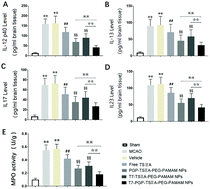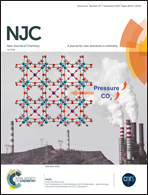Neutrophil affinity for PGP and HAIYPRH (T7) peptide dual-ligand functionalized nanoformulation enhances the brain delivery of tanshinone IIA and exerts neuroprotective effects against ischemic stroke by inhibiting proinflammatory signaling pathways†
Abstract
A great challenge to the therapy of ischemic stroke is the poor physicochemical properties and inability of the drug to cross the blood–brain barrier (BBB). In order to overcome these hurdles, we have developed a novel ischemic inflammatory site-recognizing and BBB-penetrating dual-targeting nano-drug system. The nanoformulation is functionalized with two targeting peptides: T7 is a transferrin receptor-mediated peptide with high BBB transcytosis capacity with ligands expressed on brain endothelial cells; N-acetylated proline-glycine-proline (PGP) has a high affinity for CXCR2 expressed on infiltrating neutrophils. This system has been proved to be a high-loading formulation for the neuroprotective compound, tanshinone IIA (TSIIA), and significantly improved its brain accumulation and therapeutic efficacy in a rodent model of ischemic stroke. The anti-ischemic stroke efficacy of TSIIA-loaded T7-PGP dual-modified PEGylated generation-5 (G5.0) hydroxyl-terminated polyamidoamine dendrimers NPs is verified by its ameliorated neuronal apoptosis and overload of intracellular Ca2+ and proinflammatory cytokines (IL-12p40, IL-13, IL-17 and IL-23). The molecular mechanism underlying the therapeutic efficacy of this formulation is associated with significant down-regulation of HMGB1/TLRs/MyD88/TRIF/IRAK inflammatory signaling pathways in ischemic stroke. The evidence highlights the potential of this dual-targeting delivery system in overcoming the main problem in drug delivery for CNS diseases where neuroinflammation is involved.



 Please wait while we load your content...
Please wait while we load your content...